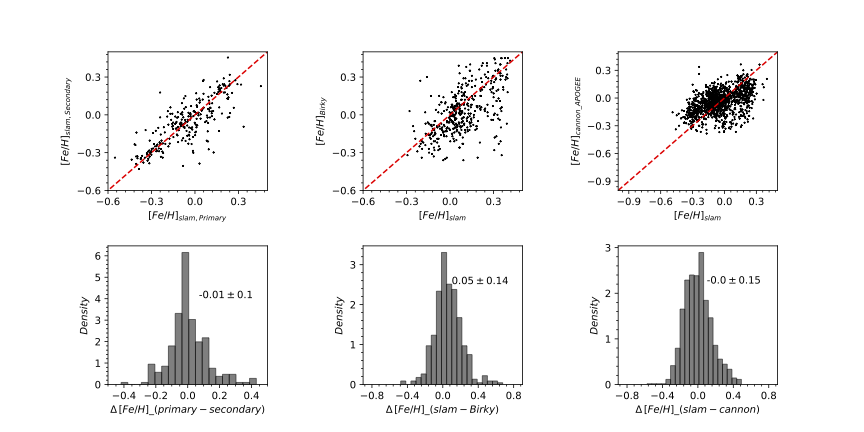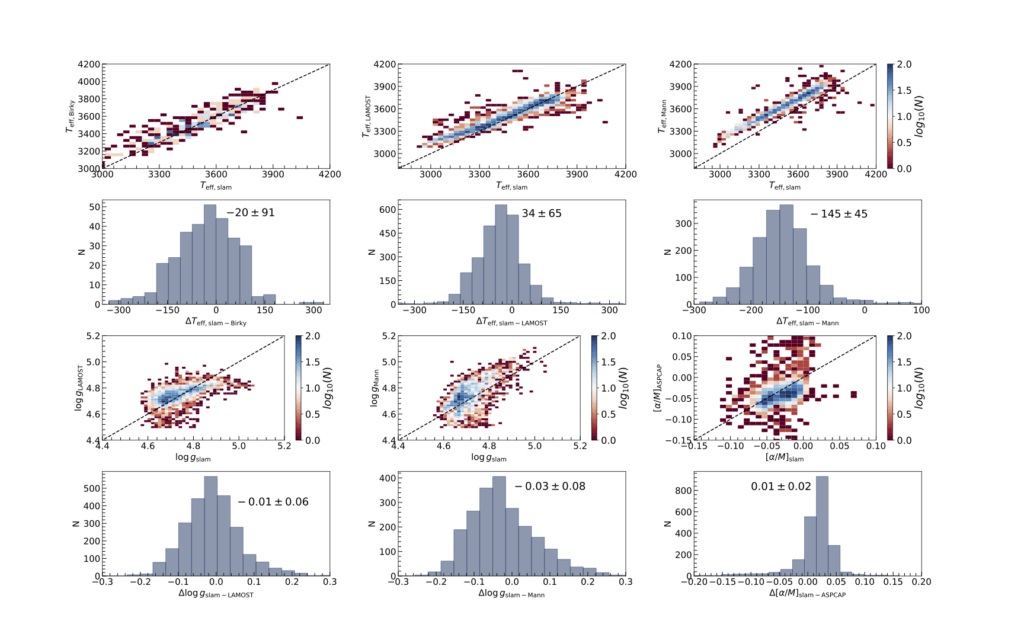Summary
Qiu et al. (2025) used the Stellar LAbel Machine (SLAM) (Zhang et al. 2020; Li et al. 2021), a data-driven method based on Support Vector Regression, to infer Teff, log g, [Fe/H] and [α/Fe]. It was trained using APOGEENet, ASPCAP and LAMOST parameters for M dwarfs in wide binaries with F, G, K primaries. It is applied to stars that the BOSS pipeline identified as M dwarfs with additional quality cuts to eliminate stars, such as pre-main-sequence stars, that were not included in the training set.
Because of the limited metallicity range of the training sample, [Fe/H] values are not reliable below [Fe/H] < -0.6.
Detailed Description
The SLAM in DR19 was used for deriving stellar parameters for M dwarfs with BOSS spectra. The SLAM model predicts the stellar parameters given a rest-frame BOSS M dwarf spectrum with the wavelength range from 6000-10000. For the purposes of training, validation, and application, M dwarfs were defined as stars with M dwarf classifications from the BOSS pipeline that also met the following criteria based on Gaia DR3 parameters:
- MG0 > 6
- MG0 < 3.75(BP-RP)0 +7.50
- MG0 < 3.28(BP-RP)0 +0.10
- ruwe < 1.4
Support Vector Regression was adopted to model the non-linear changes in normalized flux as a function of Teff and log g for M dwarfs. The BOSS spectra were normalized by first smoothing the spectrum with a smoothing spline and deriving the pseudo-continuum. The observed spectra were then normalized by dividing by this pseudo-continuum.
To train the SLAM, reliable stellar parameters are needed for M dwarfs with BOSS spectra. Qiu et al. identified 1120 M dwarfs with BOSS spectra and an FGK wide binary companion from the El-Badry et al. (2021) catalog with a LAMOST spectrum and [Fe/H]. The LAMOST [Fe/H] values are from the LAMOST Stellar Parameter pipeline (LASP, Wu et al. 2014) The wide binaries also met the following quality criteria:
- [Fe/H] uncertainty < 0.2 dex for LAMOST F, G, or K primary
- Chance Alignment Probability from El -Badry et al of R_chance_align < 0.1
- Gaia DR3 ruwe < 1.4 and ruwe2 < 1.4
Teff and log g were adopted from the DR19 APOGEENet values. [Fe/H] comes from LAMOST DR11 . [α/Fe] is adopted from the DR19 ASPCAP values.
Data Products
In DR 19, SLAM is executed on the combined spectra stored in ‘mwmStar’ BOSS M dwarf spectra. SLAM produces only one summary data product based on the combined `mwmStar` BOSS spectra (`astraAllStarSlam’).
Validation and Uncertainties
Qiu et al. (2025) validated their stellar parameters and abundances through consistency in M+M binaries and comparison with independent determinations. The leftmost plots in Figure 1 below show the metallicities derived by the SLAM for the components of M+M wide binaries. These should have the same metallicities, so the lack of bias and small scatter is encouraging. The next two comparisons take advantage of the fact that ~104 M dwarfs have both APOGEE and BOSS spectra. The middle panels show the comparison with values from Birky et al. (2020), who used metallicities of FGK binary companions of M dwarfs with APOGEE spectra to train a Cannon model and derive abundances for ~6000 M dwarfs. The rightmost panels show the comparison between the SLAM and the metallicities from Behmard et al. (2025), which used a larger training sample for the Cannon to get the metallicities for ~16,500 M dwarfs with APOGEE spectra.

Figure 2 shows the comparisons for Teff, log g, and [α/Fe]. For Teff, SLAM values were compared with values from Birky et al. (2020), derived from a Cannon model trained on photometric temperatures (Mann et al. 2015). , LAMOST values from Du et al. (2024), derived from a neural net with labels from a variety of sources, and Mann et al. (2015), who provided a metallicity-independent empirical relationship between Teff and 2MASS and Gaia magnitudes. The agreement is good for the first two comparison, but there is a large offset for the Mann comparison. For log g, Qiu et al. (2025) show the comparison between the SLAM values and LAMOST values from Du et al. (2024) and Mann et al. (2015). For [α/Fe], there are no independent measurements,so the bottom right panels show the comparison between SLAM [α/Fe] and the [α/Fe] from DR19 ASPCAP.

The uncertainties reported by SLAM are underestimated compared to the scatter of these cross-validations, which strongly depends on the spectrum signal-to-noise ratio (snr). So we set the uncertainties of four stellar parameters as the function of the snr as follows
![]()
![]()
![]()
![]()
The uncertainties of [Fe/H], [α/M], Teff and log g can reach 0.19 dex, 0.04 dex, 146 K and 0.1 dex, respectively, at snr=10.
Qiu et al. (2025) compared the ASPCAP and SLAM [Fe/H] values and found a systematic offset, as has been found in previous work (e.g., Souto et al (2020)). They suggest the following equation to adjust ASPCAP values
where x and y are Teff, ASPCAP/1000 and [Fe/H]ASPCAP, respectively.
Flags
| Field Name | Bit | Flag Name | Flag Description |
result_flags | 0 | BAD_OPTIMIZER_STATUS | Optimizer status value indicate results may not be reliable |
result_flags | 1 | TEFF_OUTSIDE_BOUNDS | Teff is outside reliable bounds: (2800, 4500) |
result_flags | 2 | FE_H_OUTSIDE_BOUNDS | [Fe/H] is outside reliable bounds: (-1, 0.5) |
result_flags | 3 | OUTSIDE_PHOTOMETRY_RANGE | Outside 1.5 < BP – RP < 3.5 and 6 < M_G < 12, which approximates the range SLAM was trained on |
flag_warn | — | WARN | If BAD_OPTIMIZER_STATUS or OUTSIDE_PHOTOMETRY_RANGE are set. |
flag_bad | — | BAD | If any of the following flags are set: TEFF_OUTSIDE_BOUNDS, FE_H_OUTSIDE_BOUNDS, OUTSIDE_PHOTOMETRY_RANGE, BAD_OPTIMIZER_STATUS. |
